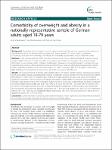Comorbidity of overweight and obesity in a nationally representative sample of German adults aged 18-79 years
Schienkiewitz, Anja
Mensink, Gert
Scheidt-Nave, Christa
Background: Overweight has increased in many countries over the past 20 years and excessive body weight is an established risk factor for adverse health outcomes and chronic diseases. This study aimed to determine comorbidity associated with overweight and obesity in a nationally representative sample of German adults. Methods: In the German National Health Interview and Examination Survey 1998 standardized measures of body weight, height and waist circumference (WC) were obtained for 7,124 men and women 18 to 79 years of age. Information on pre-existing health conditions, health-related behaviors, and sociodemographic characteristics was collected using physician-administered computer-assisted interviews and self-administered questionnaires. World Health Organization (WHO) cut-off criteria were applied to define overweight (BMI 25.0-29.9 kg/m2) and obesity (BMI ≥30.0 kg/m2) and abdominal obesity (men: WC ≥102 cm; women: WC ≥88 cm). Results: The crude prevalence of persons with cardiometabolic risk factors, diabetes mellitus, cardiovascular disease (CVD), gall bladder disease, and osteoarthritis showed a significant stepwise increase from the lowest to the highest BMI category in both sexes. In multiple logistic regression models adjusting for age, social status, and smoking, significant associations with overweight and obesity persisted for cardiometabolic risk factors and osteoarthritis. For example, obese persons had a three- to fourfold higher chance of having any cardiometabolic risk factor compared to normal weight persons (odds ratio (OR) = 4.07, 95% CI: 3.16-5.25 for men; OR = 3.40 (2.60-4.46) for women). Only in women, overweight and obesity as well as abdominal obesity, independent of BMI category, were significantly and consistently associated with diabetes (overweight: OR = 1.85 (1.03-3.30); obesity: OR = 2.94 (1.63-5.31); abdominal obesity: OR = 1.44 (1.08-1.92) and gall bladder disease (overweight: OR = 1.65 (1.22-2.25); obesity: OR = 3.06 (2.26-4.14); abdominal obesity: OR = 1.73 (1.25-2.39)). Conclusion: Current estimates of disease burden underline the public health importance and clinical relevance related to overweight and obesity and needs to take into account comorbidity aspects.
No license information

